|
ESCAPES
|
 |
|
In many respects Stobs was in the ideal position for the location
of a Prisoner of War camp. It was surrounded on all sides by the bleak hills and the large training garrison and
there were very few ways out of the area. But these facts did not stop a succession of escape attempts from 1915
onwards.
|
|
|
The first breakout was also perhaps the most audacious for the four escapees
left Hawick on the afternoon train for Edinburgh! Two of the men were quickly recaptured, one at Granton and the
other at Leith Docks. One of the men had been a boatswains mate on the 'Blucher'. The eventual fate of the other
two escapees is not recorded.
Two months later, another former sailor on the 'Blucher' escaped, this time in a southerly direction, Carl Michalski
being recaptured near Newcastleton.
|
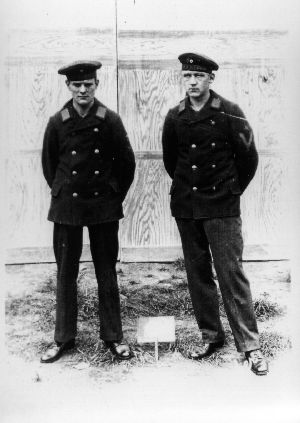 |
He had discarded his POW camp coat with its distinctive blue patch in the centre,
which all the prisoners at Stobs had to wear, but the trousers, with their distinguishing patch on the hips, could
not be disguised and he was recaptured.
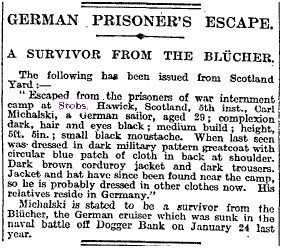
|
|
The most amazing, and nearly successful bid for freedom, was detailed in the Hawick Express
of September 21st, 1917:
'It transpires that
the 6 escaped German prisoners who were captured by the British naval patrol in the North Sea a fortnight ago were
the men who got away from Stobs. They made their way across the hills and moors, and were supposed to have made
for Newbigging Point, where they hoped a boat would be in readiness for them. They struck the coast a few miles
north of the point, just below Amble, where they succeeded in buying provisions, and in the neighbourhood of the
little fishing village of Cresswell they came across a boat which they seized. The boat was sighted by a trawler
170 miles from land, and a passing destroyer took them prisoner. There were submarine prisoners among them, and
some of them had revolvers. Two had Iron Crosses.'
|
Three weeks later, another group of prisoners broke out of the camp, the headlines in the Hawick Express
reading: 'FIVE HUNS AT LARGE'. The men were from the German navy and still wore their
naval uniforms or the camp corduroy.
If their particular style of dress did not raise suspicions then the fact that the prisoner Julius Pilz had a fractured
left leg when he escaped may have given their game away. Of his fellow escapees, Paul Schultze had a tattoo on
his left arm, while both George Giffers Hominn and Renhold Kreft bore scars. Only Wilhelf Borehurstand was fortunate
enough not to rate a description in the press. |
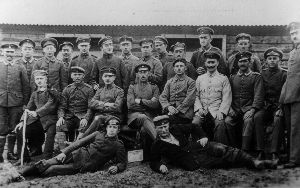 |
|
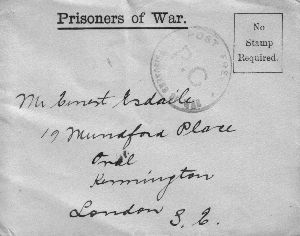
|
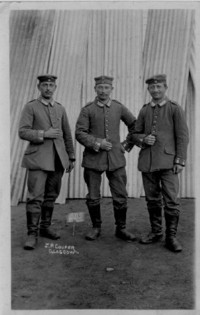
|
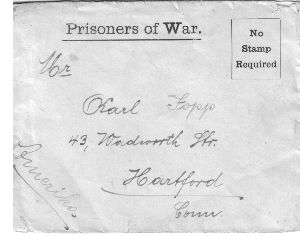
|
|
The last of the prisoners of war left Stobs for their homes in Germany towards the end of 1919.
They left behind over 40 of their number buried in a foreign land.
|
|
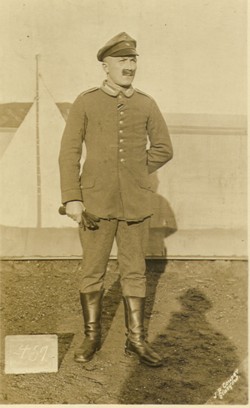
|
Nikolaus Trieschmann was a Prisoner of war in Stobs camp from
April 1917 to Nov 1919.
He was captured in January, 1917, on the Somme near Le Sars in
France.
His photos are courtesy of Bernd Koch, Nikolaus's grandson of Gelnhausen
near Frankfurt, Germany.
The picture was in the form of a postcard taken at Stobs by the
photographer J.P.Couper from Glasgow
|
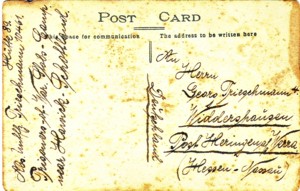
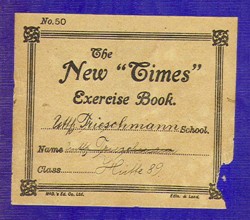
|
|
|
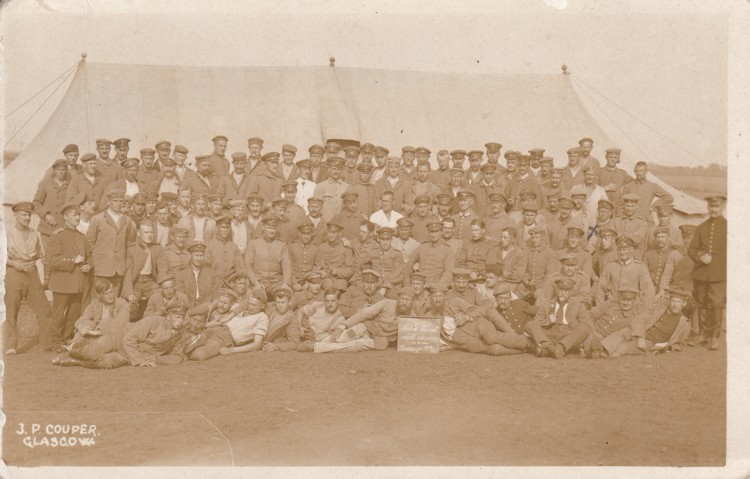
|
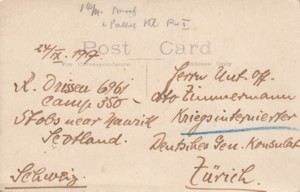
The postcard to the left and above was kindly sent by Hans Stricker whose grandfather was a POW
at Stobs Camp from 1916 to 1919.
He worked in the Camp hospital because he was a first-aid man.
The postcard says "Nach der Heimat möcht ich wieder" Beecraigs 1914-1917
Beecraigs, a park near Edinburgh, had German POWs working the the foresty there in 1916. The photo may have either
been taken there or at Stobs as the above photo shows the rear of the card as is addressed from Stobs.
|
|
|
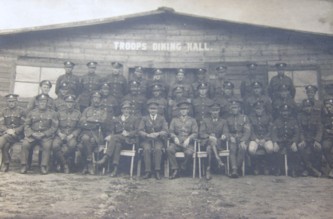
|
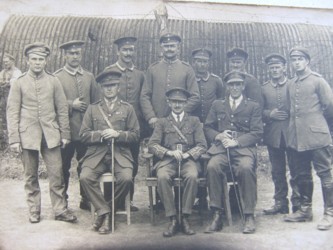
|
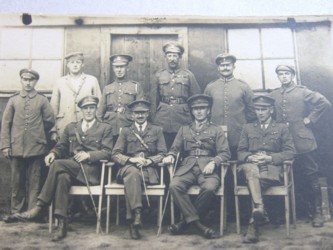
|
|
Lt Percy Jones Devonshire Regt was responsible for the POW Camp at Stobs and he was presented
with a carved figure by the German Prisoners.
Lt Percy Jones ( we believe he was injured in battle and sent to Scotland ) served at the Camp in 1918-1919. He
is seated 3rd from the left in the officer group photo, and on the left with the German Prisoners in the background.
My thanks to Stephen and Deborah Durber for the three photographs above.
|
|
|
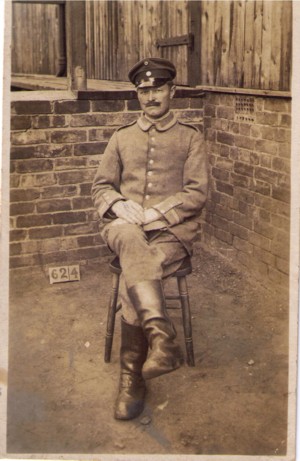
|
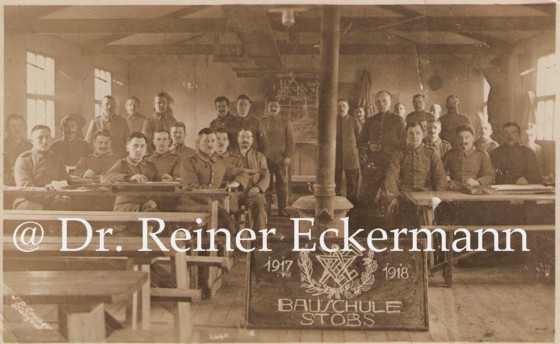
Willy Eckermann, who was with the 4. Ersatz-Division, Brigade Ersatz Battalion Nr. 33
when he became POW in 1916. In Stobs, he was Prisoner of War No.10168, Hut 75, from October 1916 to 1919. Willy
Eckermann lived in Bergedorf near Hamburg, Germany. He was a mason and finished his education in the Stobs "Bauschule"
(Building Construction School) from 1917 to 1918. He became a famous man in his home town and built a lot of buildings
around there.
My thanks to his Grandson, Dr. Reiner Eckermann, for the photos and information.
|
|
|
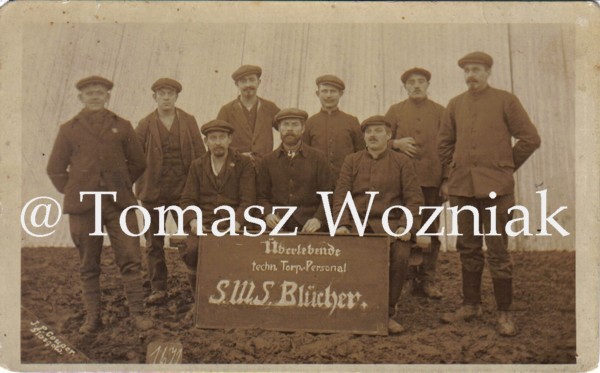
|
Tomasz Wozniak from Poland sent me the postcard on the left.
It shows his Great Grandfather - Edward Wozniak at Stobs
Edward was a sailor on S.M.S. Blucher
(Sitting, first on the right). |
|
|
Judith Rosenhagen from Germany sent me the postcard on the right.
She found it in an old photo album which had belonged to her late Grandpa.
The wording on the board says in old German script:
Schuhmacher Innung
Gefangenenlager
Stobs 1917
The Shoemakers Guild at Stobs in 1917.
One of them is Judith's Grandpa's uncle,
Reinhold Grell from Nowawes (now Potsdam-Babelsberg).
He was a shoe maker in civilian life and was housed in Camp D, barrack room 145 at Stobs, prisoner
number 1176.
|
 |
|
|
Another fascinating postcard sent by Judith Rosenhagen on the right.
The cap ribbon reads "Unterseeboots Abteilung" - so this seaman was a captured German
submariner.
|
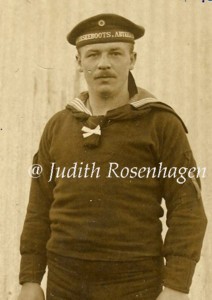 |
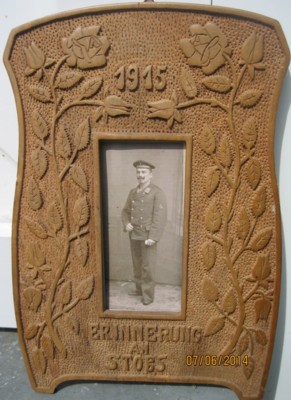
The above photograph in a Stobs frame shows August Butscheck, one of the men off the "Blucher"
who was interred at Stobs from 1915.
My thanks to Astrid Kandulla, the Grand-daughter of August.
|
| |
|
|
|
 |

|

|